Food waste silently drains profit from restaurants every single day. But cutting waste doesn’t mean cutting quality — and it doesn’t mean serving smaller portions or cheaper food.
The best-run kitchens going into 2026 are the ones that tighten systems, not standards.
Here’s how to reduce waste while keeping your food quality high.
1. Fix Prep Overproduction First
Most waste happens before food ever touches a plate.
Instead of guessing, start:
-
Tracking how much you actually sell per day
-
Prepping based on real numbers, not habits
-
Reducing “just in case” prep
-
Making smaller, more frequent batches
Fresh food in smaller waves creates better quality and less trash.
2. Use First-In, First-Out Without Overthinking It
FIFO doesn’t need charts or labels everywhere — it just needs discipline.
Simple habits:
-
Always pulling older product to the front
-
Training staff to reach for the oldest item first
-
Not allowing “hidden” containers in the back of coolers
A fast cooler check once per shift saves hundreds of dollars a month.
3. Control Portion Creep
Waste isn’t only what gets thrown out — it’s what gets over-served.
Avoid portion creep by:
-
Using standard scoops and ladles
-
Weighing proteins once during training
-
Showing visual portion examples at prep stations
Guests don’t need more food to feel satisfied — they need consistent food.
4. Turn Trim Into Value
There’s a difference between waste and opportunity.
Smart kitchens:
-
Use vegetable trims for stocks
-
Turn protein scraps into soups or staff meals
-
Create daily specials based on surplus product
This keeps freshness high while keeping food cost tight.
5. Train Staff to Treat Food Like Money
Waste decreases when your team understands the value.
That means:
-
Teaching team members what waste costs daily
-
Showing them how small mistakes add up
-
Making waste reduction part of kitchen culture
When staff respect the product, quality naturally stays high.
6. Track Waste Without Complicated Systems
You don’t need expensive software or spreadsheets.
Simple methods:
-
A dry erase board near the prep area
-
Tally marks for thrown-away items
-
A quick daily review with kitchen leads
Awareness creates improvement.
7. Quality Comes From Systems, Not Excess
High-quality food does not come from excess prep or oversized portions.
It comes from:
-
Controlled systems
-
Fresher batches
-
Better handling
-
Clear training
Restaurants that reduce waste properly don’t feel like they’re cutting back — they feel cleaner, faster, and more consistent.
Final Thought
Reducing waste isn’t about serving less — it’s about running smarter.
Better systems
Tighter habits
Cleaner kitchens
Higher profits
That’s how you protect quality while improving margins.






